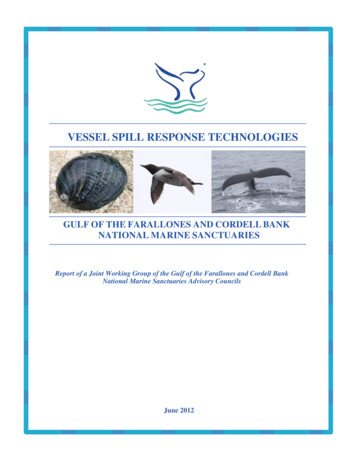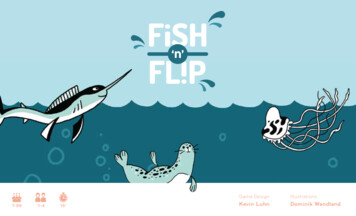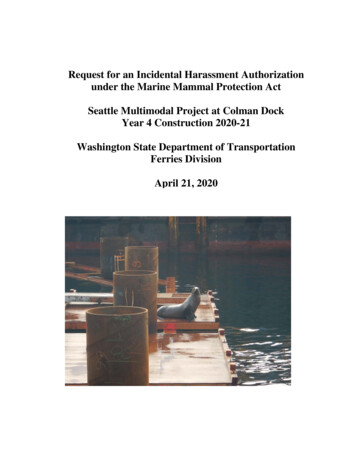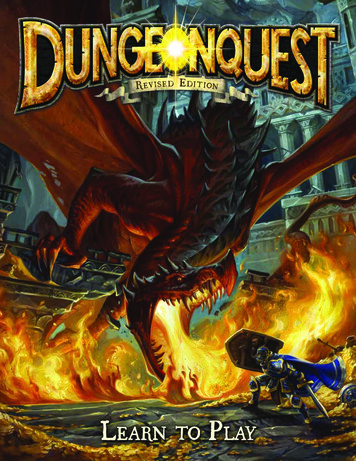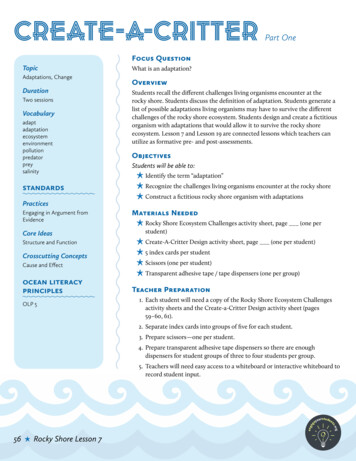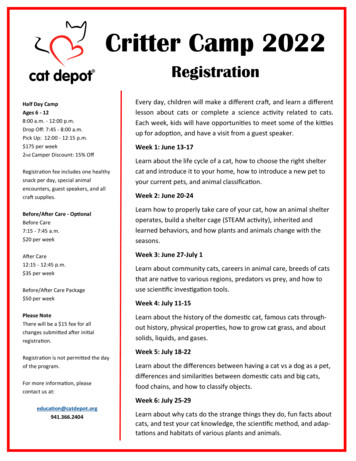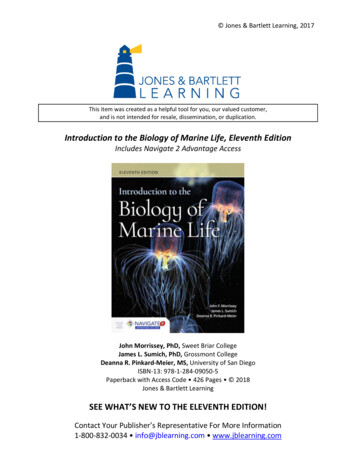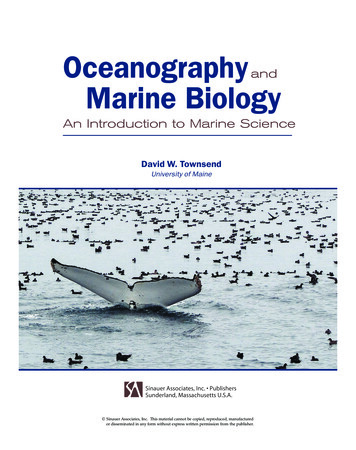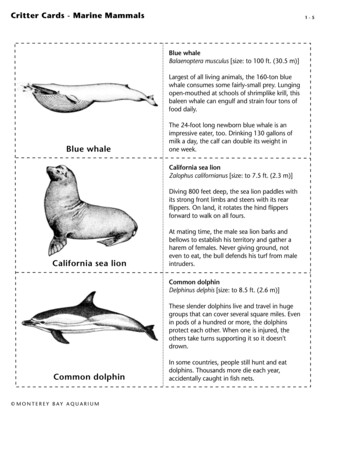
Transcription
Critter Cards - Marine Mammals1-5Blue whaleBalaenoptera musculus [size: to 100 ft. (30.5 m)]Largest of all living animals, the 160-ton bluewhale consumes some fairly-small prey. Lungingopen-mouthed at schools of shrimplike krill, thisbaleen whale can engulf and strain four tons offood daily.Blue whaleThe 24-foot long newborn blue whale is animpressive eater, too. Drinking 130 gallons ofmilk a day, the calf can double its weight inone week.California sea lionZalophus californianus [size: to 7.5 ft. (2.3 m)]Diving 800 feet deep, the sea lion paddles withits strong front limbs and steers with its rearflippers. On land, it rotates the hind flippersforward to walk on all fours.California sea lionAt mating time, the male sea lion barks andbellows to establish his territory and gather aharem of females. Never giving ground, noteven to eat, the bull defends his turf from maleintruders.Common dolphinDelphinus delphis [size: to 8.5 ft. (2.6 m)]These slender dolphins live and travel in hugegroups that can cover several square miles. Evenin pods of a hundred or more, the dolphinsprotect each other. When one is injured, theothers take turns supporting it so it doesn'tdrown.Common dolphin MONTEREY BAY AQUARIUMIn some countries, people still hunt and eatdolphins. Thousands more die each year,accidentally caught in fish nets.
Critter Cards - Marine Mammals2-5Dall's porpoisePhocoenoides dalli [size: to 7 ft. (2.1 m)]This stocky porpoise has a small dorsal fin and tinyflippers, but it's a spectacular swimmer. Movinglike a hydroplane, it races through the water,leaving behind a "rooster tail" of spray when itsurfaces for air.For food, the Dall's porpoise favors deep seafishing. It roams out beyond the continental shelfto hunt for squids, crustaceans and fishes.Dall's porpoiseFin whaleBalaenoptera physalis [size: to 88 ft. (27 m)]The world's second largest animal, the fin whalecan cruise the open ocean at speeds of 35 milesan hour. Most other whales can't swim so fast forextended periods.Fin whaleUneven coloring makes the fin whale uniqueamong all whales; its lower jaw is white on theright and black on the left. Dark and light patternson its body may disguise the fin whale as it huntsfishes.Gray whaleEschrichtuis robustus [size: to 50 ft. (15 m)]Gray whales make the longest migration of anymammal, swimming 12,000 miles each year. Infall, they head south to their breeding lagoons inBaja California; in spring, they return north tofeed in the Bering Sea.Gray whale MONTEREY BAY AQUARIUMUnlike other baleen whales, the gray whale eatsbottom-living crustaceans. The whale sucks in amouthful of mud and strains it through thebaleen to remove the prey.
Critter Cards - Marine Mammals3-5Harbor porpoisePhocoena phocoena [size: to 6 ft. (1.8 m)]The stocky harbor porpoise lives near shore inharbors, bays and river mouths. Wary of boats, itwon't cruise alongside them, preferring to swimquietly on the surface.Harbor porpoises work cooperatively to huntsquids and fishes. The porpoises herd a school offish into a tight ball, then each porpoise grabs afish head-first and swallows it whole.Harbor porpoiseHarbor sealPhoca vitulinla [size: to 5 ft. (1.5 m)]A harbor seal can't "walk" on land the way a sealion can. On shore, the harbor seal has to inchalong awkwardly on its belly, But in water, it's agraceful swimmer, powered by its webbed hindflippers.Harbor sealHarbor seals don't migrate far from home. Theyhunt fishes, squids and octopuses near shore,using their large eyes and sensitive whiskers tohelp them locate prey.Humpback whaleMegaptera novaeangliae [size: to 51 ft. (15.6 m)]Humpback whales travel between their Arcticfeeding grounds and tropical breeding grounds.Some migrate to Hawaii and some to Mexico; afew visit both sites in different years.Humpback whale MONTEREY BAY AQUARIUMIn the breeding areas, the males display theirgreat vocal range with songs that may warn offother males or attract females. As they sing, thewhales gradually alter their song, so each year it'sa different melody.
Critter Cards - Marine Mammals4-5Minke whaleBalaenoptera acutorostrata [size: to 35 ft. (10.7 m)]Although it's as long as a bus, the minke whale isthe smallest of the baleen whales. As agile as aporpoise, it can leap from the water in a gracefularc or ride the bow wave of a passing ship.Alone or with a companion, the minke whalehunts squids, fishes and krill. The whale jumpsand splashes to gather its prey in a ball, thenlunges in to scoop up the cluster.Minke WhaleNorthern elephant sealMirounga angustirostris [size: to 19.5 ft. (5.9 m)]Once hunted to near-extinction, elephant sealsare now breeding successfully again. At matingtime, they move ashore, the males battling forposition. With snorts of warning, the dominantbulls defend their females against rival males.After breeding, the elephant seals return to thesea to feed. Diving deeper than 2,700 feet, theyhunt deep water fishes and squids.Northern elephant sealPacific white-sided dolphinLagenorhynchus obliquidens [size: to 7 ft. (2.1 m)]Resident pods of hundreds of white-sideddolphins streak through Monterey Bay. They swimin formation with other dolphins and sea lions,sometimes leaping from the water in spiritedsomersaults.Pacific white-sided dolphin MONTEREY BAY AQUARIUMEach dolphin is unique, from the patterns on itsbody to the noises it makes. High-pitchedsqueaks, clicks and whistles help it communicatewith its family pod.
Critter Cards - Marine Mammals5-5Sea otterEnhydra lutris [size: to 5.5 ft. (1.7 m)]For warmth, the sea otter relies on its thick furcoat with 600,000 hairs per square inch. The otterspends nearly half its waking hours grooming itsfur coat to keep it waterproof.The otter dives for shellfish, then eats lying on itsback at the surface. Because it consumes abalonesand crabs, the otter sometimes competes withpeople for food.Sea OtterSei whaleBalaenoptera borealis [size: to 60 ft. (18.5 m)]Sei whales cruise the oceans from polar regions tothe tropics. Unlike other baleen whales, they don'thave predictable migration routes but seem tofollow their prey, trailing the northward fishmigrations.Sei whaleSwimming near the surface, the whale skims smallinvertebrates from the sea. As it feeds, the whale'sthroat pleats expand like an accordion to holdtons of water and prey.Sperm whalePhyseter macrocephalus [size: to 62 ft. (18.9 m)]Diving a mile or more below the surface, thesperm whale makes clicking noises to echolocatefor prey. When it finds a shark or giant squid, thewhale stuns it with a blast of sound and swallowsit whole.Sperm whale MONTEREY BAY AQUARIUMFor years, whalers hunted this whale for themilk-colored oil that fills its huge square head. Noone knows what the oil is for; perhaps it helps thewhale focus sounds.
lion can. On shore, the harbor seal has to inch along awkwardly on its belly, But in water, it's a graceful swimmer, powered by its webbed hind flippers. Harbor seals don't migrate far from home. They hunt fishes, squids and octopuses near shore, using their large eyes and sensitive whiskers to help them locate prey.


